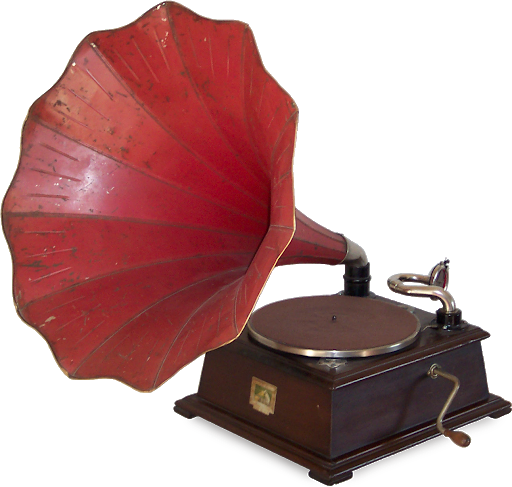
This image has format transparent PNG with resolution 512x487.
You can download this image in best resolution from this page and use it for design and web design.
Gramophone PNG with transparent background you can download for free, just click on download button.
A phonograph, in its later forms also called a gramophone (as a trademark since 1887, as a generic name in the UK since 1910) or since the 1940s called a record player, is a device for the mechanical recording and reproduction of sound. The sound vibration waveforms are recorded as corresponding physical deviations of a spiral groove engraved, etched, incised, or impressed into the surface of a rotating cylinder or disc, called a "record". To recreate the sound, the surface is similarly rotated while a playback stylus traces the groove and is therefore vibrated by it, very faintly reproducing the recorded sound. In early acoustic phonographs, the stylus vibrated a diaphragm which produced sound waves which were coupled to the open air through a flaring horn, or directly to the listener's ears through stethoscope-type earphones.
The phonograph was invented in 1877 by Thomas Edison. Alexander Graham Bell's Volta Laboratory made several improvements in the 1880s and introduced the graphophone, including the use of wax-coated cardboard cylinders and a cutting stylus that moved from side to side in a zigzag groove around the record. In the 1890s, Emile Berliner initiated the transition from phonograph cylinders to flat discs with a spiral groove running from the periphery to near the center, coining the term gramophone for disc record players, which is predominantly used in many languages. Later improvements through the years included modifications to the turntable and its drive system, the stylus or needle, and the sound and equalization systems.
The disc phonograph record was the dominant audio recording format throughout most of the 20th century. In the 1980s, phonograph use on a standard record player declined sharply due to the rise of the cassette tape, compact disc, and other digital recording formats. However, records are still a favorite format for some audiophiles, DJs and turntablists (particularly in hip hop and electronic dance music), and have undergone a revival since the 1990s. The original recordings of musicians, which may have been recorded on tape or digital methods, are sometimes re-issued on vinyl.
Usage of terminology is not uniform across the English-speaking world (see below). In more modern usage, the playback device is often called a "turntable", "record player", or "record changer", although each of these terms denote categorically distinct items. When used in conjunction with a mixer as part of a DJ setup, turntables are often colloquially called "decks". In later electric phonographs (more often known since the 1940s as record players or, most recently, turntables), the motions of the stylus are converted into an analogous electrical signal by a transducer, then converted back into sound by a loudspeaker.
The term phonograph ("sound writing") was derived from the Greek words φωνή (phonē, "sound" or "voice") and γραφή (graphē, "writing"). The similar related terms gramophone (from the Greek γράμμα gramma "letter" and φωνή phōnē "voice") and graphophone have similar root meanings. The roots were already familiar from existing 19th-century words such as photograph ("light writing"), telegraph ("distant writing"), and telephone ("distant sound"). The new term may have been influenced by the existing words phonographic and phonography, which referred to a system of phonetic shorthand; in 1852 The New York Times carried an advertisement for "Professor Webster's phonographic class", and in 1859 the New York State Teachers Association tabled a motion to "employ a phonographic recorder" to record its meetings.
Arguably, any device used to record sound or reproduce recorded sound could be called a type of "phonograph", but in common practice the word has come to mean historic technologies of sound recording, involving audio-frequency modulations of a physical trace or groove. In the late-19th and early-20th centuries, "Phonograph", "Gramophone", "Graphophone", "Zonophone", "Graphonole" and the like were still brand names specific to various makers of sometimes very different (i.e. cylinder and disc) machines; so considerable use was made of the generic term "talking machine", especially in print. "Talking machine" had earlier been used to refer to complicated devices which produced a crude imitation of speech, by simulating the workings of the vocal cords, tongue, and lips – a potential source of confusion both then and now.
In this page you can download free PNG images: Gramophone PNG images free download